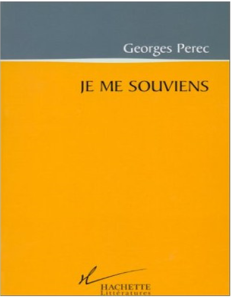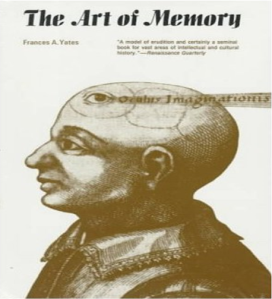 If the impossibility of dealing with loss comprehensively has led to a sense of a ‘task’ to be achieved, then it is perhaps no surprise to find the term ‘memory work’ increasingly used in contemporary cultural theory. And if one method of going about this work is to employ a ritualistic, or repetitive, process for ‘listing’ loss, then it is worthwhile considering an example of just such memory work, from what I call the ‘I remember’ school of writers inspired by Joe Brainard’s book of the same title. I Remember was first published in 1975 and consisted of a series of entries, all beginning with the words ‘I remember’, in which Brainard recollected moments from his past, some of them highly individual and others doubtless shared by an enormous number of his contemporaries. To take a typical trio of consecutive entries:
If the impossibility of dealing with loss comprehensively has led to a sense of a ‘task’ to be achieved, then it is perhaps no surprise to find the term ‘memory work’ increasingly used in contemporary cultural theory. And if one method of going about this work is to employ a ritualistic, or repetitive, process for ‘listing’ loss, then it is worthwhile considering an example of just such memory work, from what I call the ‘I remember’ school of writers inspired by Joe Brainard’s book of the same title. I Remember was first published in 1975 and consisted of a series of entries, all beginning with the words ‘I remember’, in which Brainard recollected moments from his past, some of them highly individual and others doubtless shared by an enormous number of his contemporaries. To take a typical trio of consecutive entries:
I remember the first time I saw television. Lucille Ball was taking ballet lessons.
I remember the day John Kennedy was shot.
I remember that for my fifth birthday all I wanted was an off-one-shoulder black satin evening gown. I got it. And I wore it to my birthday party.
(Joe Brainard, I Remember (New York: Granary Books, 2001 [1975]), p. 9.)
The originality in Brainard’s technique lies in the intermingling of personal and collective memories and in the recognition that the catalogue of human life as compiled by memory is made up equally of intense personal experiences, public events, fads, fashions and myths. Brainard’s work shows how each person simultaneously carries within them official and unofficial histories, the contents of which are always at varying stages of being recalled or forgotten. The Kennedy assassination, for example, is an event unlikely to be forgotten in either official history or the unofficial history of a certain group of people alive at a particular time and in at least some level of connection via mass media with the rest of the world (Brainard’s generation, in other words). Indeed, for such a group, whose hegemony over these matters is only recently beginning to wane, this event has become the classic example of such individualized-yet-shared memory, with people being said to know exactly where they were when they heard the news of the president’s murder. In the new millennium this event has been succeeded for many by the events of September 11 2001. Yet if these events are subject to both official and unofficial memory, highly personal recollections such as those collated by Brainard still have within them a quality that is transferable to others who have experienced something comparable or who can connect to them simply through the fact that they too have remembered (things). Indeed it might well be said that it is in the highly personal, idiosyncratic details (Brainard’s evening gown) that the possibility for a universal recognition resides.
 That is not to say, however, that such memory work is necessarily translatable to other cultural contexts. Although Brainard’s book was translated into French by Marie Chaix, the French ‘version’ of I Remember which found most success and which has itself come to be regarded as a classic of the genre, is Georges Perec’s Je me souviens (1978). Perec reduces the autobiographical elements of Brainard’s work to a certain extent, although these are still a prominent feature of his version alongside a higher proportion of memories likely to be shared with others. In producing a more pronounced cultural bias to the book, Perec is forced away from literal translation and towards the creation of a new work steeped in the resonance of the French imaginary. Perec’s intention was to seek out, via his own recollection, moments of memory that could be ‘deconsecrated’ and returned to their ‘collectivity’; speaking about the book he claimed, ‘what came out most clearly for me was that I wasn’t the only one to be remembering. It’s a book I might call “sympathetic”, I mean that it’s in sympathy with its readers, that readers are perfectly at home in it.’
That is not to say, however, that such memory work is necessarily translatable to other cultural contexts. Although Brainard’s book was translated into French by Marie Chaix, the French ‘version’ of I Remember which found most success and which has itself come to be regarded as a classic of the genre, is Georges Perec’s Je me souviens (1978). Perec reduces the autobiographical elements of Brainard’s work to a certain extent, although these are still a prominent feature of his version alongside a higher proportion of memories likely to be shared with others. In producing a more pronounced cultural bias to the book, Perec is forced away from literal translation and towards the creation of a new work steeped in the resonance of the French imaginary. Perec’s intention was to seek out, via his own recollection, moments of memory that could be ‘deconsecrated’ and returned to their ‘collectivity’; speaking about the book he claimed, ‘what came out most clearly for me was that I wasn’t the only one to be remembering. It’s a book I might call “sympathetic”, I mean that it’s in sympathy with its readers, that readers are perfectly at home in it.’
 The fact that Perec’s work increased the ratio of culturally shared to personal memories from Brainard’s original was recognized in 1986 by the British writer Gilbert Adair when he decided to publish his own version of the ‘I remember’ template in his book Myths & Memories. The book was devised partly as a homage to two French writers he admired, Roland Barthes and Georges Perec, and partly as an attempt to apply the techniques of Barthes’s Mythologies and Perec’s Je me souviens to a British context. In Adair’s opinion, Perec’s version of Brainard’s work was distinct enough to warrant its own ‘translation’ but a literal rendering of the French words would be pointless: ‘the fact of its being anchored in a French experience has rendered [Je me souviens] definitively untranslatable; or, rather, translatable only by way of the metamorphosis, the kind of total Anglicizing, which it undergoes here.’ (This observation has an obvious correlation with my earlier discussion of saudade. As for a Portuguese language version of I Remember, the closest parallel would appear to be a Brazilian text entitled Memorando, by Geraldo Mayrink and Fernando Moreira Salles (Sao Paulo: Companhia das Letras, 1993). I have not been able to consult this text to see how it compares with the three versions mentioned here.)
The fact that Perec’s work increased the ratio of culturally shared to personal memories from Brainard’s original was recognized in 1986 by the British writer Gilbert Adair when he decided to publish his own version of the ‘I remember’ template in his book Myths & Memories. The book was devised partly as a homage to two French writers he admired, Roland Barthes and Georges Perec, and partly as an attempt to apply the techniques of Barthes’s Mythologies and Perec’s Je me souviens to a British context. In Adair’s opinion, Perec’s version of Brainard’s work was distinct enough to warrant its own ‘translation’ but a literal rendering of the French words would be pointless: ‘the fact of its being anchored in a French experience has rendered [Je me souviens] definitively untranslatable; or, rather, translatable only by way of the metamorphosis, the kind of total Anglicizing, which it undergoes here.’ (This observation has an obvious correlation with my earlier discussion of saudade. As for a Portuguese language version of I Remember, the closest parallel would appear to be a Brazilian text entitled Memorando, by Geraldo Mayrink and Fernando Moreira Salles (Sao Paulo: Companhia das Letras, 1993). I have not been able to consult this text to see how it compares with the three versions mentioned here.)
 Adair’s conflation of the work of Barthes and Perec serves as an intriguing invitation to think about the concept of mythology alongside that of memory. This has been a strategy taken up by a number of historians in recent years, especially those concerned with memory’s associations with place. Prominent amongst these have been Raphael Samuel and Pierre Nora. Samuel’s ‘theatres of memory’ and Nora’s lieux de mémoire are both influenced by the work of Frances Yates, whose exploration of ‘the art of memory’ relies on notions of myth and place, yet there is an equally important role played by repetition – indeed, memory thought of as an art is born of the desire to be able to repeat. In this sense, it is interesting to note a connection between these historians and the work of the ‘memorians’ of the ‘I remember’ school. In the latter we find a recourse to a ritualistic process (anamnesis, recollection) grounded in the repeated act; this repetition is continued in the representation of memory as these writers follow the unchanging mantra of ‘I remember…’.
Adair’s conflation of the work of Barthes and Perec serves as an intriguing invitation to think about the concept of mythology alongside that of memory. This has been a strategy taken up by a number of historians in recent years, especially those concerned with memory’s associations with place. Prominent amongst these have been Raphael Samuel and Pierre Nora. Samuel’s ‘theatres of memory’ and Nora’s lieux de mémoire are both influenced by the work of Frances Yates, whose exploration of ‘the art of memory’ relies on notions of myth and place, yet there is an equally important role played by repetition – indeed, memory thought of as an art is born of the desire to be able to repeat. In this sense, it is interesting to note a connection between these historians and the work of the ‘memorians’ of the ‘I remember’ school. In the latter we find a recourse to a ritualistic process (anamnesis, recollection) grounded in the repeated act; this repetition is continued in the representation of memory as these writers follow the unchanging mantra of ‘I remember…’.
This is a device often used in popular songs, where memories are listed over various verses. Fado is no exception, containing a number of such songs. Katia Guerreiro’s ‘Romper Madrugadas’, for example, provides a verse form built upon lines that begin with the word ‘recordo’ [I remember]: ‘Recordo os segredos das noites da bruma / Recordo os teus dedos bebidos de espuma / Recordo o teu cheiro de amor perfumado / Tristeza em sorriso num corpo rasgado’ [I remember the secrets of the nights of mist / I remember your fingers dipped in foam / I remember your smell of fragrant love]. From an earlier point in the twentieth century, we might look to Alfredo Marceneiro’s ‘Lembro-Me de Ti’, each verse of which begins with the line ‘I remember you’ and carries with it another memory. With seven verses and a running time of nearly six minutes the overall effect is one of extended ritual punctuated and regulated by the highly emotional lilt given to the title line by Marceneiro. Indeed the song is straining with emotion, Marceneiro’s voice sounding as though it might break under the force of the memory and giving the song an emphatically nostalgic air.
The ritualized recitation of memory can also be found to account for irrevocable loss. Amália Rodrigues provides an excellent example in her self-written fado ‘Gostava de Ser Quem Era’:
Tinha uma louca esperança
Tinha fé no meu destino
Tinha sonhos de criança
Tinha um mundo pequeninoTinha toda a minha rua
Tinha as outras raparigas
Tinha estrelas tinha a lua
Tinha rodas de cantigasGostava de ser quem era
Pois quando eu era menina
Tinha toda a Primavera
Só numa flor pequenina[I had a crazy hope
Had faith in my destiny
Had childhood dreams
Had a tiny worldI had all my street
Had the other girls
Had stars had the moon
Had song wheels [children’s game]I would like to be who I used to be
Because when I was a little girl
I had the entire Spring
Within just a tiny flower]
The ‘tinha’ (‘I had’) that begins each line of the first three verses of the song (the first is not quoted above) and that is multiplied in Amália’s performance by the repetition of the last two lines of each verse, produces a litanistic quality that hints, even though it is not stated explicitly, that these things have been lost forever. The final verse seals this assumption with the confession that the singer used to like being who she was, with the concomitant suggestion that she no longer does.
The potential infinitude of memory work suggests that there is little that is not worth remembering. Noting the ‘acceleration of history’, Pierre Nora writes, ‘Everything is historical, everything is worth remembering, and everything belongs to our memory.’ Accompanying history’s acceleration we find an acceleration of chroniclers and rememberers, both amateur and professional, a process that has been immeasurably widened by the invention and development of the internet. To take a couple of recent web-based developments in the growing ubiquity of chronicling and remembering, there has been an explosion in the amount of ‘encyclopaedic’ information available (most notable in the phenomenon of Wikipedia) and of personal archives (blogs), many of which contain both autobiographical information and theoretical explication or discussion of wider issues. It was perhaps inevitable that the project initiated by Brainard and developed by Perec and Adair would find its modus operandi continued via the medium of the internet with ‘I remember’ blogs. (See also Zeina Abirached’s comic book, Je me souviens: Beyrouth (sample pages here)).
